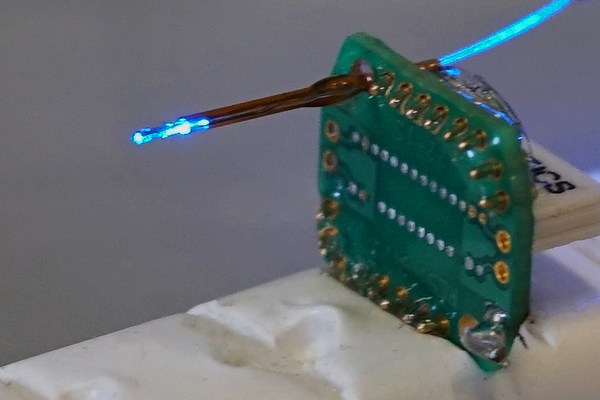
Photo: Levin Sottru
Through extensive comparative testing in living organisms a neurobiological task force surrounding Prof Dr Ilka Diester and her PhD student Stephanie Hardung was able to show, what probe design qualifies for which objective. Apart from common procedures for recording nerve signals, their research project takes into account recent manipulation techniques which, with the help of genetic manipulation and light, allow for a spatially and temporally precise intervention. The group affiliated with the BrainLinks-BrainTools cluster of excellence and the Bernstein Center Freiburg has now published their study in the journal ‚Frontiers in Systems Neuroscience‘.
„Many of the electrode implants that are currently available allow not only an extraction of information about neuronal processes but also for a systematic intervention”, says Diester. “Finding the right balance between cost and benefit, however, it is not always that easy. Let alone ensuring a maximized performance in both directions”, Hardung remarks. How well a simultaneous input and output works out depends on the complex interaction of different factors which are generally inherent to the design of the implant. The research team selected two different types of implants for their study: Fixed probes in a so-called array structure and movable drives, which allow reaching an optimal position for measurement and stimulation even after the implantation. Two varieties of each category were implanted into the cerebral cortices of rats and over several weeks underwent a series of tests examining their performance, range, precision, stability and adaptation procedures.
With the help of electrophysiology, which means by extracting electric signals, the researchers recorded their neuronal activity. They further used optogenetics to influence cellular behavior. Optogenetics is a novel approach where nerve cells are genetically altered in a way that their electric activity can be controlled with the help of light. The advantages are convincing: “Optogenetic approaches are fast and unerring, in principle they show few side effects and the alterations are reversible”, says Diester.
Diester and Hardung had already anticipated that they would be able to control larger regions with arrays due to their higher number of electrodes. But their team was also able to confirm that array solutions are relatively stable and mostly economical. The micro drives, which focus on smaller areas, turned out to offer a better recording quality and further modification capabilities, but were also generally more fragile and more expensive. “Microwire-Arrays are perfectly sufficient for basic research experiments or simple experiments aimed at showing initial applicability”, Hardung concludes. This is different, however, when research focuses on behaviorally relevant nervous pathways, which are anatomically difficult to reach. Diester and Hardung agree that in this case movable drives might lead to breakthroughs.
Original publication:
Hardung S, Alyahyay M, Eriksson D, Diester I, A toolbox for optophysiological experiments in freely moving rats Front. Sys. Neurosci. doi: 10.3389/fnsys.217.00027